Sold Ceramics
Sold Blue and White Kangxi Period 1662-1722
Tea, Coffee and Chocolate wares
Page 3
Around 1680, Emperor Kangxi (1662–1722) established his authority over all parts of China after a long period of civil strife. The porcelain factories in Jingdezhen that were demolished in 1675 resumed production and within a few years exports were booming. Chinese junks sailed to Batavia, bringing their porcelain to the market. From there, it was shipped to the Netherlands in VOC (Dutch East India Company, 1602–1799) vessels. However, private individuals bypassed the Company and also imported huge quantities of porcelain to Holland. In Europe, a change in dining habits and the introduction of tea and coffee created new demands. New varieties of Chinese export porcelain were produced, including all kinds of Western shapes. Porcelain, sometimes in miniature, was frequently used to decorate house interiors in Europe.
Much porcelain of this period is decorated in a clear, transparent underglaze blue. Popular decorations included the Buddhist lotus motif, a pheasant with long tail feathers on a rock amidst flowers, and the ‘Long Eliza’ with the 'Dancing Fool', the Dutch name for a Chinese lady and a small boy depicted in a garden.
Kangxi porcelain is very well made, with a thin body, a balanced shape and a smooth glaze without impurities. Cobalt blue oxide was subtly applied in varying degrees of saturation, suggesting depth and volume. The colour ranges from a silvery to a deep dark blue; in the best pieces the details and the craftsmanship are amazing. However, due to stricter controls by officials, the freedom and easy way of painting that was so characteristic of the preceding Transitional period now gave way to a more formal style with an emphasis on symmetry and centralism.
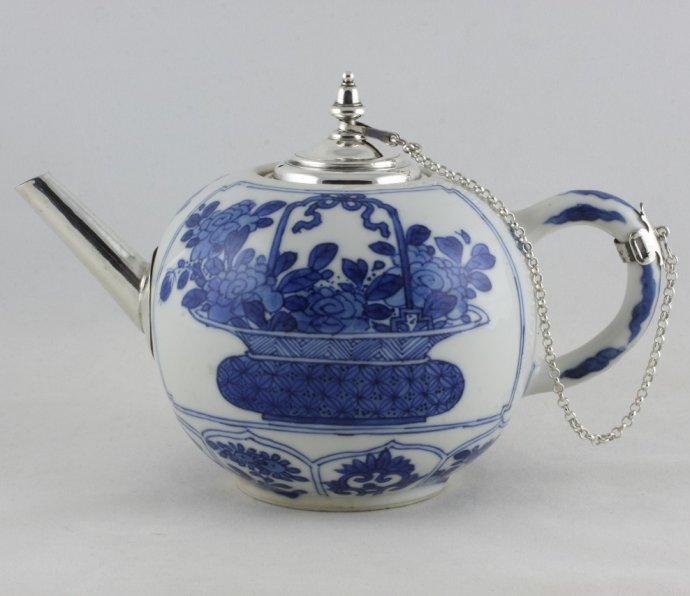
Sold Ceramics - Sold Blue and White Kangxi Period 1662-1722 - Tea, Coffee and Chocolate wares - Page 3
Object 2012297
Teapot
China
1700-1720
Height with cover 112 mm (4.41 inch), height without cover 85 mm (3.35 inch), diameter handle to spout 174 mm (6.85 inch), diameter of mouthrim 45 mm (1.77 inch), diameter of footring 53 mm (2.09 inch), weight including cover 326 grams (11.49 ounce (oz.)), weight cover 31 grams (1.09 ounce (oz.))
Globular teapot on a footring. The original spout is missing and replaced by a straight silver spout. Curved C-shaped handle. The original cover is missing and replaced by an inlaying silver cover which is connected by a silver chain to a silver mount on the handle. Decorated in underglaze blue on one side with a panel filled with wicker flower basket with handles and ribbons filled with various flowering plants on the reverse side another panel filled with a basket with cover on a low table surrounded by books, scrolls, a leaf, a single flower and antiquities. Round the foot petal shaped panels filled with flower sprays. above and below the spout a single flower spray and on the handle various flower sprays.
Only grown in China and Japan during the 17th Century, tea became known in the Netherlands early because the Dutch East India Company (VOC) shipped small quantities home. Its use as a beverage was established slowly, and was probably started by retired VOC employees who had become accustomed to drinking tea in the East. At a tea party, the expensive beverage was served in small teapots, one for each guest, filled with the leaves of the type he or she preferred. The tea was poured into small cups, while the teapot was refilled with hot water from a metal or sometimes ceramic kettle. (Jörg 2011/2, p.131)
Condition: Replaced spout and cover, a short firing tension hairline above the handle, caused by the firing process.
Price: Sold.
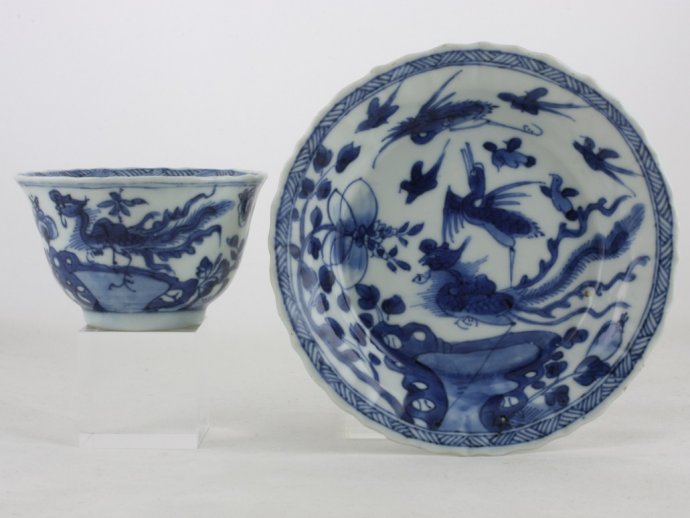
Sold Ceramics - Sold Blue and White Kangxi Period 1662-1722 - Tea, Coffee and Chocolate wares - Page 3
Object 2011739
Teacup and saucer
China
1700-1720
Height of teacup 52 mm (2.05 inch), diameter of rim 84 mm (3.31 inch), diameter of footring: 36 mm (1.42 inch), weight 74 grams (2.61 ounce (oz.))
Height of saucer 24 mm (0.94 inch), diameter of rim 134 mm (5.28 inch), diameter of footring 71 mm (2.80 inch), weight 106 grams (3.74 ounce (oz.))
Teacup and saucer on footrings, the teacup with a slightly everted moulded rim and a scalloped edge, the saucer with a moulded flat rim and a scalloped edge. Decorated in underglaze blue with a phoenix perched on pierced rockwork flanked by flowering plants. In the air two courting cranes and various birds in flight. Around the rim a zig-zag lines pattern border. On the reverse, around the footring, a border of twelve moulded lotus petals. The teacup is decorated en suite.
Grus montignesia, or the Manchurian crane. 'Next to the fêng (vide PHOENIX), this bird is the most celebrated in Chinese legends, in which it is endowed with many mythical attributes. It is reputed as the patriarch of the feathered tribe and the aerial courser of the immortals. The crane itself is an auspicious symbol, representing longevity and wisdom. They accompany Daoist immortals (xian, hsien) bringing from The Isles of Paradise the tablets in their beaks. A pair of cranes symbolizes 'Long Marriage' as cranes mate for life. (Williams 1976, p.101), (Pijl-Ketel 1982, p.279)
The standing Phoenix and his environment that since he is a chimerical creature, the phoenix may adopt the 'image' of natural birds and also 'influence' them to stimulate him, provided only stunning beauty is the result. This unique creature is composed of admirable parts of various animals. The phoenix has the head of a pheasant, surmounted by a cock's comb, the beak of a swallow, the neck of a tortoise. He subsides on the seeds of bamboo and on sacred springs. He is virtue and benevolence, strides rather than walks. He is over six feet tall. Flying, he fills the air with music. The feng huang is the phoenix of Chinese writers, and like its counterpart in Arabian history, is adorned with everything that is beautiful among birds. The etymology of the name implies that itis the Emperor of all birds; and as is the unicorn among quadrupeds so is the phoenix the most honourable among the feathered tribes. (Williams 1976, p.323), (Harrisson 1979, pp.63-68)
To this day there are 16 identically shaped and decorated teacups and saucers in the Hluboká Castle (Prague) collection with this ornamentation, so it can be assumed that the nobility used this crockery, especially on festive occasions. The decoration represents the classic type abundantly used towards the end of the Kangxi period. Similar cups with phoenix or crane motifs were also found during the archaeological exploration of the shipwrecked Chinese junk known as the Ca Mau (1725). (Amsterdam 2007, pp.116-117), (Suchomel 2015, p.224)
For an identically shaped and decorated teacup and saucer, please see:
Condition:
Teacup: A restored frit and hairline to the rm.
Saucer: A short hairline and some tiny frits to the rim. Some frits and chips to the footring
References:
Price: Sold.
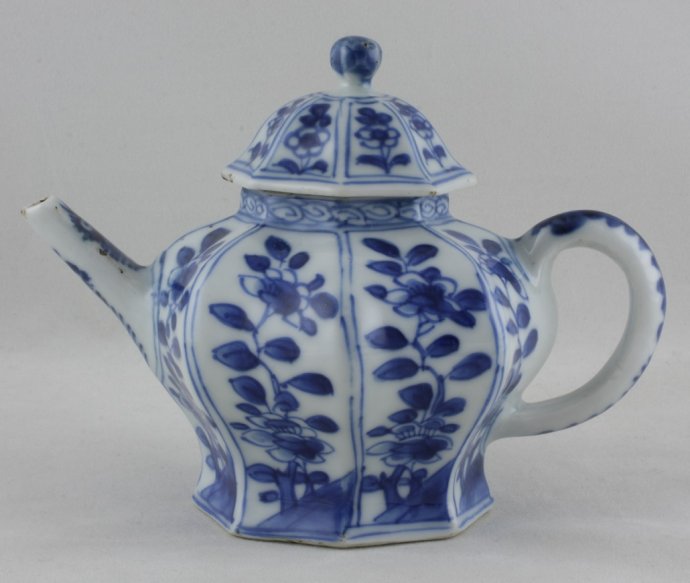
Sold Ceramics - Sold Blue and White Kangxi Period 1662-1722 - Tea, Coffee and Chocolate wares - Page 3
Object 2012326
Teapot
China
1700-1720
Height 100 mm (3.94 inch), diameter handle to spout 133 mm (5.24 inch), diameter of mouthrim 36 mm (1.41 inch), diameter of footring: 55 mm (2.17 inch), weight with cover 235 grams (8.29 ounce (oz.)), weight cover 41 grams (1.45 ounce (oz.))
Teapot, octagonal shaped on an octagonal footring. Straight spout and C-shaped handle. Domed cover with a round knob. Decorated in underglaze blue with flowering plants on each facet. Around the neck a spiral pattern border and on the handle and spout a single flowering stem. The cover is decorated en suite.
For an identically shaped, sized and in underglaze blue decorated teapot, please see:
For an identically shaped, sized and in Chinese Imari decorated teapot, please see:
Condition: Some glaze rough spots and a fleabite to the edge of the cover and a fleabite and frit to the tip of the spout.
Reference:
Lunsingh Scheurleer 1982/2, cat. 31
Price: Sold.

Sold Ceramics - Sold Blue and White Kangxi Period 1662-1722 - Tea, Coffee and Chocolate wares - Page 3
Object 2011925
Saucer
China
1700-1720
Height 17 mm (0.67 inch), diameter of rim 112 mm (4.41 inch), diameter of footring 56 mm (2.20 inch), weight 71 grams (2.50 ounce (oz.)),
Saucer on footring, the sides moulded into panels, a flat rim with a scalloped edge. Decorated in underglaze blue with an erotic scene of a landscape with a half-naked man lying on a mattress, a kneeling naked woman beside him. On the rim a border of swastika motifs. On the reverse the panels are filled with flowering stems alternating with fungi, around the rim flower heads with leafy scrolls.
Erotic scenes are rare in Chinese Art and mainly known from 'pillow books', series of illustrations of sexual positions, said to have been used as manuals for the young and newlywed. On porcelain openly erotic scenes are even rarer. A few examples are known from the Transitional period, e.g. the tall cups found in the Hatcher cargo c.1643, which indicates the existence of sets with different decorations. During the Qing dynasty such subjects are equally rare, with the exception of erotic scenes in the Western style on Chine de commande. The present scene is known, with slight variations, only from teacups and saucers, not from other tea items. Surprisingly, these cups and saucers are not rare. (Sheaf & Kilburn 1988, p.67, Pl.100), (Jörg & Van Campen 1997, p.113, cat. 113)
An identically shaped, sized and decorated saucer is in the collection of Augustus the Strong in Dresden and registered under the number P.O. (Porzellan Ostasien) 7444 b. For this saucer, please see;
For an identically shaped and decorated teacup and saucer, please see:
Condition: A firing flaw with a frit to the footring, two very tiny fleabites and a T-shaped hairline to the rim.
References:
Sheaf & Kilburn 1988, p.67, Pl.100
Jörg & Van Campen 1997, cat. 113
SKD Online collection, PO. 7444 b
Price: Sold.
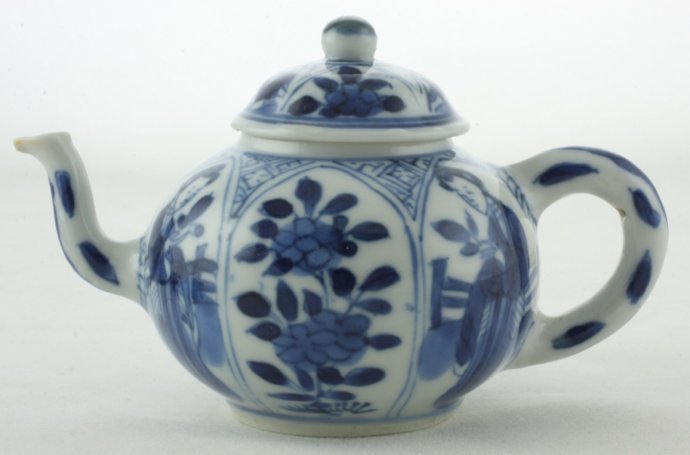
Sold Ceramics - Sold Blue and White Kangxi Period 1662-1722 - Tea, Coffee and Chocolate wares - Page 3
Object 2011112
Miniature teapot
China
c.1700
Height 57 mm (2.24 inch), diameter handle to spout 9.4 mm (3.70 inch), diameter of mouthrim 29 mm (1.14 inch), diameter of footring 32 mm (1.26 inch)
A small / miniature teapot on footring, globular, wide low mouthrim,. Domed cover with knob. S-shaped spout and C-shaped handle. Decorated in underglaze-blue with six moulded panels showing a flowering plant alternating with two panels with a "Long Eliza". Round the neck a trellis pattern border On the cover four panels showing blooming flowers alternating with little dancing boys in a fenced garden. On the handle and spout sprays of leaves. Marked on the base with the single character mark: Yu, (Jade (Yuan to Qing)), underglaze blue
In the Netherlands, these slender women engaged in some form of activity in a landscape or on a veranda, were called lange lijzen, translated in English as Long Eliza's. The Yu, "jade", character mark is traditionally called the F-mark in the Netherlands and is very common on good-quality blue and white Kangxi export porcelain. (Jörg & Van Campen 1997, p.115), (Jörg 2002/2, p.96)
For a similarly decorated teapot, please see:
Condition: A restored spout.
References:
Jörg & Van Campen 1997, cat. 116
Price: Sold.

Sold Ceramics - Sold Blue and White Kangxi Period 1662-1722 - Tea, Coffee and Chocolate wares - Page 3
Object 2010783
Teacup and saucer
China
c.1700
Height of teacup 44 mm (1.73 inch), diameter of rim 67 mm (2.64 inch), diameter of footring 31 mm (1.22 inch)
Height of saucer 17 mm (0.66 inch), diameter of rim 119 mm (4.69 inch), diameter of footring 64 mm (2.52 inch)
Teacup and saucer on footrings, slightly everted rims. Decorated in underglaze blue with, so-called, hatching lines technique with a central roundel filled with a flower head, on the sides eight lotus petal-shaped panels filled with leafy scrolls, around the inner rim a meander pattern border. On the reverse leafy sprays, on the base a shop mark in a double circle in underglaze blue. The teacup is decorated en suite.
These criss-cross hatching lines are not a Chinese way of painting on porcelain and may have been influenced by the Dutch. This technique was short-lived for it mostly occurs on blue-and-white export wares around 1700. It occurs on teacups and saucers, beakers and small jars with covers, garnitures and other items. The style was short lived, disappearing in the early 18th century. (Jörg & Flecker 2001, pp.68-69)
Condition teacup: A chip and a hairline to the rim.
Condition saucer: A frit, hairline and some tiny spots on the rim, caused by popped bubbles of glaze during the firing process.
References:
Jörg & Van Campen 1997, cat. 117
Jörg & Flecker 2001, fig 55-58
Price: Sold.

Sold Ceramics - Sold Blue and White Kangxi Period 1662-1722 - Tea, Coffee and Chocolate wares - Page 3
Object 2011572
Miniature teapot
China
c.1700
Height 54 mm (2.13 inch), diameter handle to spout 92 mm (3.62 inch), diameter of mouthrim 35 mm (1.38 inch), diameter of footring 33 mm (1.30 inch), weight with cover 79 grams (2.79 ounce (oz.)), weight cover 14 grams (0.49 ounce (oz.))
Oviform miniature teapot on footring, wide low mouthrim. Domed cover with round knob. Straight spout and C-shaped handle. Decorated in underglaze-blue with various flowering plants growing from pierced rockwork. Around the mouthrim a zig-zag lines border. On the cover various flowering plants growing from pierced rockwork. The handle and spout with flowering stems. The cover has been pierced.
Condition: A restored spout and chip to the rim.
Price: Sold.

Sold Ceramics - Sold Blue and White Kangxi Period 1662-1722 - Tea, Coffee and Chocolate wares - Page 3
Object 2011730
Saucer
China
1710-1730
Height 20 mm (0.79 inch), diameter of rim 113 mm (4.45 inch), diameter of footring 63 mm (2.48 inch), weight 54 grams (1.90 ounce (oz.))
Saucer on footring, slightly everted rim. Decorated in underglaze blue with, from right to left, carp swimming up a river, trying to leap up a gate and pass above the rapids to transform into dragons. On the rim a wave pattern border. The reverse is undecorated. The matching teacup is missing.
Fish are among the earliest known subjects on Chinese ceramics appearing in the Neolithic period of the fifth to fourth millennium BC. Fish are rich in symbolic meaning and are a symbol of wealth and abundance. Because of the phonetic similarity between the word yu, meaning fish, and yu, meaning abundance, images of fish in Chine came to be considered emblematic of wealth and prosperity. The reproductive power of fish is regarded as a symbol of regeneration and fecundity. And because fish are thought to swim in pairs, they are reputed to be the emblem of the joys of union, particularly of the sexual kind. The scene depicted on this saucer tells about the carp that swim up the Yellow river every year, and which on their way must leap up the Dragon Gate Falls. Not a single carp, however, out of a hundred, a thousand, or even ten thousand, can climb the falls, not even after ten or twenty years. Some are swept away by the strong currents, some fall prey to eagles, hawks, kites, and owls, and others are netted, scooped up, or even shot with arrows by fishermen who line both banks of the falls ten chō wide. Those that succeed in passing the gate above the rapids are transformed into dragons. (Kerr 1986, p.79), (Ströber 2011, p.102), (nichirenlibrary.org)
Condition: A frit with a short connected hairline to the rim.
References:
Price: Sold.
More picures of object 2011729, another identically shaped, sized and decorated, sold saucer >>

Sold Ceramics - Sold Blue and White Kangxi Period 1662-1722 - Tea, Coffee and Chocolate wares - Page 3
Object 2010482
Teacup and saucer
China
1700-1720
Height of teacup 30 mm (1.18 inch), diameter of rim 46 mm (1.81 inch), diameter of footring 24 mm (0.95 inch)
Height of saucer 18 mm (0.71 inch), diameter of rim 74 mm (2.91 inch), diameter of footring 40 mm (1.58 inch)
Teacup and saucer on footrings. Decorated in underglaze blue with a figure sitting on a shore under a tree in a riverscape with boats, mountains trees and the sun. Th teacup is decorated en suite.
Condition teacup: Three tiny fleabites to the rim
Condition saucer: Five tiny fleabites to the rim and two spots on the rim, caused by a popped bubble of glaze during the firing process.
Price: Sold.

Sold Ceramics - Sold Blue and White Kangxi Period 1662-1722 - Tea, Coffee and Chocolate wares - Page 3
Object 2011714A
Saucer
China
1700-1720
Height 19 mm (0.75 inch), diameter of rim 116 mm (4.57 inch), diameter of footring 57 mm (2.24 inch), weight 50 grams (1.76 ounce (oz.))
Saucer on footring, slightly everted rim. Decorated in underglaze blue with a moonlit riverscape indicating that this scene was taking place at night with the poet, Su Shi (Su Dongpo,1037-1101) and his companions in a boat which approaches the shore of the 'Red Cliff' to the right. Around the rim a zig-zag lines pattern border. The reverse is undecorated. The matching teacup is missing.
'The Red Cliff Ode', (chi bi fu), was the name given to two Chinese prose poems written by Su Shi (Su Dongpo,1037-1101). The first 'The Red Cliff Ode' was written in the summer of 1082.
Ströber states that the poems were written when the poet was in exile in Huangzhou in the modern province of Hubei. It tells the story of a boating trip of Su Shi with guests over the Yangzhi-river in 1082. The men are at leisure, drinking wine, playing the flute while the boat is drifting beneath the red cliffs on the water. They engage in a philosophical discussion about the shortness of life and the changing and changeless aspects of things. The second poem is the description of another journey to the 'Red Cliff' which the poet undertook a couple of months later. The theme of the poem of the 'Red Cliff' as a decorative motif for porcelain appears on numerous objects of the 17th century and was particularly popular with Chinese scholars. (Ströber 2001, pp.104-105)
The 'Red Cliff' design was also used on Japanese porcelain. Fitski states that in 18th-century Japan a strong movement was devoted to Chinese culture. This had originated in the mid 17-th century when, after the fall of the Ming-dynasty in 1644, various intellectuals and monks fled from southern China to Japan. The influence of their intellectual legacy created a renewed interest for Chinese culture, Confucius studies, poetry and painting. It also led to a renewed popularity of the image of the scholar as a hermit or as an unadapted person. Especially for officials, often unsatisfied by the way Japanese governmental control was being executed, the scholar who, in solitude, could devote himself to calligraphy, poetry or art was an idealistic image. The movement also had an influence on the decoration of porcelain. On a Japanese dish we see a similar depiction of the 'Red Cliff' journey. The appreciation of Chinese motifs continued until the Meiji period; this teacup is a mid 19-century interpretation of this scene. (Fitski 2002, pp.46-47)
For a Japanese teacup, decorated with the 'Red Cliff' design, that was donated by Pater Gratia Oriental art, in December 2012, to the collection of Oriental Ceramics of the Groninger Museum, Groningen, The Netherlands, please see:
Bowls with this scene also appear on two still-life paintings dated 1627 and 1638 by the French artist Jacques Linard.(source: aziatischekeramiek.nl)
Chinese bowls from the Transitional and Kangxi periods with a similar decoration are not rare; some examples, admittedly of poor quality, were salvaged from The Hatcher Junk, c.1643, please see:
For a Ming bowl with similar decoration, please see:
For a Zhangzhou (Swatow) bowl with similar decoration, please see:
For a special bowl from the Kangxi period decorated with the first and second prose poems (Chinese fu) of The Red Cliff Ode (chi bi fu), please see:
For a brush holder from the Kangxi period decorated with overglaze gold on a powder-blue ground with the first and second prose poems (Chinese fu) of The Red Cliff Ode (chi bi fu), please see:
Condition: Perfect.
References:
Jörg & Van Campen 1997, cat. 33
Adhyatman 1999, cat. 108 & 108b
Price: Sold.
More pictures of object 2011714B, another identically shaped, sized and decorated, sold saucer >>
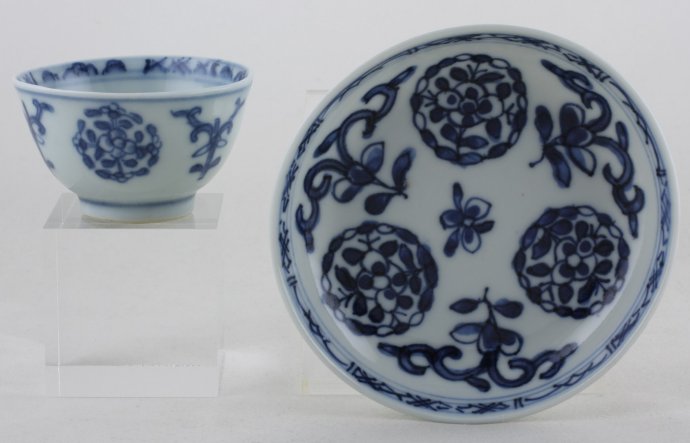
Sold Ceramics - Sold Blue and White Kangxi Period 1662-1722 - Tea, Coffee and Chocolate wares - Page 3
Object 201099A
Tea bowl and saucer
China
1700-1720
Height of tea bowl 33 mm (1.30 inch), diameter of rim 55 mm (2.17 inch), diameter of footring 23 mm (0.91 inch), weight 28 grams (0.99 ounce (oz.))
Height of saucer 21 mm (0.83 inch), diameter of rim 85 mm (3.35 inch), diameter of footring 46 mm (1.81 inch), weight 39 grams (1.38 ounce (oz.))
Teacup and saucer on footrings. Decorated in underglaze blue with a central flower head on the sides three roundels filled with a flower head and leaves alternating with a single flower spray. Round the rim four reserves filled with grasses on a trellis pattern ground. The reverse is undecorated. The teacup is decorated en suite.
Condition teacup: Two tiny fleabites to the rim
Condition saucer: Perfect.
Price: Sold.


 create websites
create websites